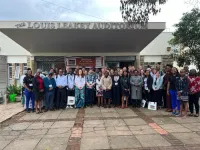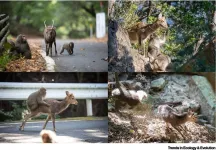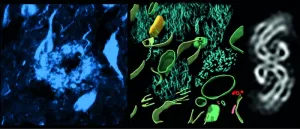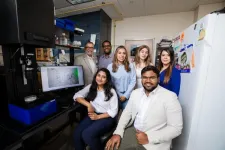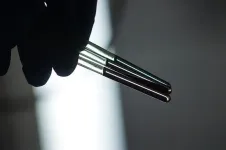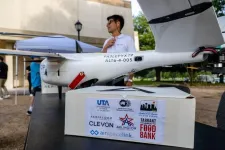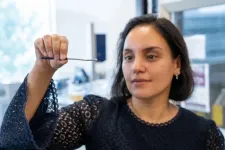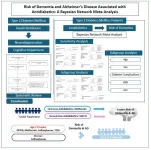(Press-News.org) (Santa Barbara, Calif.) — Birds migrating. Your cat, returning home from a day of roaming. Bees taking pollen to their hives. You, finding yourself back home without actually remembering the drive from work. Animal navigation is a fundamental behavior, so innate that most of the time we don’t notice that we’re doing it. And yet, so many times a day we (and the animals around us) unerringly find our ways to our target locations whether they be old haunts or new venues, from different directions and even in the dark.
How do we do it? That’s the question UC Santa Barbara neurobiologist Sung Soo Kim seeks to answer; more specifically, his work involves mapping networks of neurons involved in wayfinding. “My ultimate goal is to understand how the brain processes visual information and generates navigational commands to move,” he said.
With a 2024 Scholar Award from the McKnight Foundation, Kim is that much closer to his goal. He is one of 10 neuroscientists selected by the organization to receive the prestigious early-career award, which consists of $75,000 per year for three years. Kim is the first UCSB researcher to receive the award.
I’m honored to receive this award,” Kim said. “It will help me to make solid progress in my research. It also gives me an opportunity to connect with top scientists of the country."
Turns out, animals have a variety of ways to gather location information that they must then interpret to make decisions about where to go. Some rely on landmarks, others on smells and yet others on the Earth’s magnetic field. These inputs and others are transformed into a neural representation of the world that we are thought to hold in our minds to help us make navigation decisions based on our goals. It may be why we are able to avoid obstacles as we walk through a room even after the lights have been turned off.
How does this happen in the brain? To find out, Kim built a virtual reality arena for the fruit fly, a model organism in which approximately 50 “compass neurons” are arranged along the outside of a donut-shaped structure in their brains called the ellipsoid body. This simple structure encodes the fly’s sense of direction, and through the highly controlled environment of the arena, researchers can apply visual stimuli such as outdoor scenes, simulate motion and wind, and observe the tethered fly’s brain as it navigates the virtual scenes. It’s research that, according to the McKnight Foundation “looks at the combined role of perception, cognition and motor control, three subfields of systems neuroscience that are rarely connected in a single research program.”
Of particular interest to Kim for this project are the cues that we would not be able to see, but abound in the fruit fly’s world.
“Humans use a lot of landmarks like buildings and signs as cues to navigate the world,” Kim said. “For the flies, it’s a little bit different.” For one thing, he explained, fruit flies are partial to vertically oriented objects, like trees. “But the more important thing is the polarization of light in the sky. There is a very specific pattern of light in the sky that is invisible to humans but insects can see,” he said.
Just like how polarized sunglass lenses filter the horizontal light waves to reduce glare from sunlight reflections on water or snow, or the headlights from an oncoming car, the atmosphere also filters out part of the incoming sunlight, which creates patterns that insects are particularly attuned to. “Polarization, light patterns and the color of the stimulus are things that insects use for navigation,” Kim added, “And I want to understand how that information is processed in the visual system and how it is conveyed to the central brain where the navigation task is performed.”
The answers to Kim’s questions will go a long way toward gaining a basic understanding of how navigation works in animals and ultimately humans, but the results may also have some immediate practical applications. For instance, autonomous vehicles and robots that lose their link to GPS could shift into an alternative mode of navigation that collects information from their immediate surroundings and makes decisions on where to go based on that input. Looking farther out, this kind of research may also lead to insights on neurological conditions, such as Alzheimer’s disease, that often affect the parts of the brain involved in one’s sense of location.
“Of course, the fly brain is very far from the human brain,” Kim said. “But still, understanding how the navigation system works may potentially help us understand how and why the brain is malfunctioning in these cases.”
END
Neurobiologist Sung Soo Kim receives 2024 Scholar Award from McKnight Foundation
2024-07-11
ELSE PRESS RELEASES FROM THIS DATE:
Charting an equitable future for DNA and ancient DNA research in Africa
2024-07-11
CLEVELAND AND NAIROBI — July 11, 2024 — Today, the American Journal of Human Genetics published a perspective piece on the need for an equitable and inclusive future for DNA and ancient DNA (aDNA) research in Africa. The paper, coauthored by an international team of 36 scientists from Africa, North America, Asia, Australia, and Europe, was led by Dr. Elizabeth (Ebeth) Sawchuk of the Cleveland Museum of Natural History and Dr. Kendra Sirak of Harvard University.
DNA from ancient and living African peoples is critical for researchers studying our species’ evolution and population ...
Introducing co-cultures: When co-habiting animal species share culture
2024-07-11
Cooperative hunting, resource sharing, and using the same signals to communicate the same information—these are all examples of cultural sharing that have been observed between distinct animal species. In an opinion piece published June 19 in the journal Trends in Ecology & Evolution, researchers introduce the term “co-culture” to describe cultural sharing between animal species. These relationships are mutual and go beyond one species watching and mimicking another species’ behavior—in co-cultures, both species influence each other in substantial ways.
“Co-culture challenges the notion ...
Study finds health risks in switching ships from diesel to ammonia fuel
2024-07-11
As container ships the size of city blocks cross the oceans to deliver cargo, their huge diesel engines emit large quantities of air pollutants that drive climate change and have human health impacts. It has been estimated that maritime shipping accounts for almost 3 percent of global carbon dioxide emissions and the industry’s negative impacts on air quality cause about 100,000 premature deaths each year.
Decarbonizing shipping to reduce these detrimental effects is a goal of the International Maritime Organization, ...
Seeing inside Alzheimer’s disease brain
2024-07-11
Scientists investigating Alzheimer’s disease have determined the structure of molecules within a human brain for the very first time.
Published today in Nature, the study describes how scientists used cryo-electron tomography, guided by fluorescence microscopy, to explore deep inside an Alzheimer’s disease donor brain.
This gave 3-dimensional maps in which they could observe proteins, the molecular building blocks of life a million-times smaller than a grain of rice, within the brain.
The study zoomed in on two proteins that cause dementia– ‘β-amyloid’, a protein that forms microscopic ...
Nanoplastics and ‘forever chemicals’ disrupt molecular structures, functionality
2024-07-11
EL PASO, Texas (July 11, 2024) – Researchers at The University of Texas at El Paso have made significant inroads in understanding how nanoplastics and per- and polyfluoroalkyl substances (PFAS) — commonly known as forever chemicals — disrupt biomolecular structure and function. The work shows that the compounds can alter proteins found in human breast milk and infant formulas — potentially causing developmental issues downstream.
Nanoplastics and forever chemicals are manmade compounds present throughout the environment; a series of recent studies have linked them to numerous ...
Quadrupolar nuclei measured for the first time by zero-field NMR
2024-07-11
What is the structure of a particular molecule? And how do molecules interact with each other? Researchers interested in those questions frequently use nuclear magnetic resonance (NMR) spectroscopy to find answers. In NMR, a powerful external magnetic field is employed to align the spins of atomic nuclei, which are then induced to rotate by an oscillating weak magnetic field generated by coils. A change in voltage as a result can be converted to measurable frequencies. Based on this, researchers can identify the molecular structures while also revealing ...
UT Arlington research contributes $226 million to U.S. economy
2024-07-11
A new report shows that research projects at The University of Texas at Arlington contributed one quarter of a billion dollars—$226.4 million, to be exact—to the national economy through 797 vendor contracts and subcontracts between 2018 and 2022. Of those contracts, 111 were from small businesses and 87 from minority- or woman-owned businesses.
“Research coming from UT Arlington faculty and students not only helps solve some of society’s most vexing problems, but it is also an important economic driver for business development,” said Kate C. Miller, vice president for research and innovation at UTA. “This report makes clear that UTA research ...
Researchers develop a way to make lifesaving phages accessible, transportable and much easier to use
2024-07-11
The great promise of bacteriophages is that they naturally destroy bacteria, often in situations where antibiotics fail.
Until now, though, there has been no way to access them quickly and efficiently, especially in emergency cases of antibiotic resistant infections.
Researchers at McMaster University, working with a colleague from Université Laval, have developed a simple new way to store, identify, and share phages, making them more accessible to patients who need them.
“Bacteriophages ...
MD Anderson Research Highlights for July 11, 2024
2024-07-11
HOUSTON ― The University of Texas MD Anderson Cancer Center’s Research Highlights provides a glimpse into recent basic, translational and clinical cancer research from MD Anderson experts. These advances are made possible through seamless collaboration between MD Anderson’s world-leading clinicians and scientists, bringing discoveries from the lab to the clinic and back.
Recent developments at MD Anderson offer insights into mechanisms regulating metabolic programming and cellular senescence, ...
Metformin and other antidiabetic drugs can help reduce the risk of dementia in patients with type 2 diabetes
2024-07-11
Ann Arbor, July 11, 2024 – Investigators analyzing the potential cognitive effects of antidiabetic medications in records of more than 1.5 million patients with type 2 diabetes mellitus (T2DM) found risks of dementia and Alzheimer’s disease (AD) were significantly lower in patients treated with metformin and sodium glucose co-transporter-2 inhibitors (SGLT-2i) compared to other antidiabetic drugs. Their results appear in the American Journal of Preventive Medicine, published by Elsevier.
T2DM has become ...
